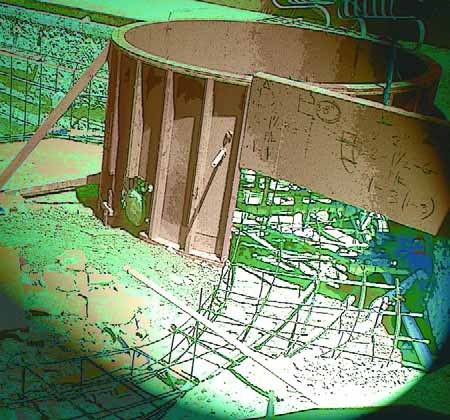column
When we think about how the environments we create are used, the first image that probably comes to mind is one of people enjoying themselves in or near the water on a beautiful, warm afternoon. That's natural - and a vision that's a big part of the watershape experience we set up for our clients - but it ignores the other half of the day when our clients are left to themselves with our work. The fact is that watershape owners are mostly working people who spend their days away from home earning their daily bread. So despite the fact that we build these things
It's not too unusual to replace all of the plumbing, equipment and electrical lines as part of a swimming pool renovation project. It's quite another story, however, when you need to make sure all of it happens without disrupting the deck surrounding the vessel. As mentioned in my last two "Details," that's precisely what we've been asked to do in renovating a 70-year-old pool in the historic Los Feliz neighborhood of Los Angeles. The presence of a beautiful, valuable, imported limestone deck means that we've had to do all of our work from inside
Few plants have been written about, lingered over and so passionately associated with fragrance, healing and serenity as lavender. Beyond stunning beauty of the sort seen in the vast purple fields of Provence, lavender has spread worldwide, leaving a trail of exquisite aroma and touching everything from our imaginations to our health. Some say lavender has pain-killing, antiseptic and skin-rejuvenating properties and that it's great for toning skin, fighting acne and soothing burns and cuts. This versatile plant is used as well to infuse perfumes, oils and soaps, and I know from my own experience that it makes a great marinade for lamb and adds
During the five years I've been writing this column for WaterShapes, I've been asked by a number of people how I manage to find the time to write this column, make presentations at trade shows, teach at Genesis 3 schools and conduct my own design/consulting business. I get the distinct impression that these questions have much less to do with curiosity about the power of time management than with questions about why I'd even bother to extend my focus beyond my primary business of
One of the real tricks in any art form can be the challenge of exercising restraint. Bigger isn't always better, and both scale and size do matter. In other words, just because you can create something grand, it doesn't always mean that you should. This principle of proportionality has a sharp, specific meaning in the world of the custom watershaper, especially when clients ask for something that is oversized for the property or more elaborate than called for by the setting or surrounding architecture. We all know where it comes from: Clients have seen something they like, and it
If the art of watershaping is ultimately about visuals, then creating a situation for yourself in which you're virtually guaranteed to create visual disruptions is something you certainly do not want to do. That's the situation I currently face in the renovation of a pool at a stunning, 1920s-vintage home in the heart of Los Angeles. As I indicated in my last column, it's a remarkably beautiful setting that features a 70-year-old pool that was well designed, expertly installed, well worth keeping - and surrounded by
Nobody seems particularly thrilled by environments devoid of light. Even at times when a lack of light is welcomed - as in the desert when you want to see the stars, or on a holiday night when you want to see a fireworks display - the events are related to light in some important way. The same attitude about light comes up when we speak of landscapes. We're always talking about "brightening up" a dark corner, for example, or "adding light" at one point or another. Whether the absence of light makes us uncomfortable or its presence is simply a
Take it from someone who has ripped out and replaced more than his share of old and failed swimming pools through the years: Some things are worth keeping! That's why it's so wonderful to find an old pool - a product of the industry's infancy - that has stood the test of time and has won the right to be left in place. This is the first in a series of columns on one such pool. It's also the start of a story about clients who appreciate art and style and have surrounded themselves with objects and spaces of true value and beauty. I knew right away that
Out of all the varieties I mentioned in last month's discussion of maples, my favorite was (and still is) the variegated maple. Beyond the simply spectacular nature of that particular tree, what I love most about them is their variegated leaves. This is clearly a personal preference. In fact, I've come across many clients and friends who have a specific disdain for variegated






















